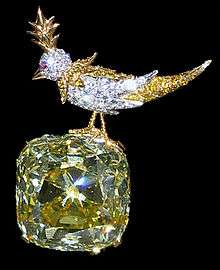Tiffany Yellow Diamond
 Tiffany Yellow Diamond in "Bird on a Rock" | |
| Weight | 128.54 carats (25.708 g) |
|---|---|
| Color | yellow |
| Cut | Modified antique cushion brilliant |
| Country of origin | South Africa |
| Mine of origin | Kimberley Mine |
| Discovered | 1878 |
| Cut by | George Frederick Kunz |
| Owner | Tiffany & Co. |
The Tiffany Yellow Diamond is one of the largest yellow diamonds ever discovered; its carat weight is 287.42 carats (57.484 g) in the rough when discovered in 1878 in the Kimberley mine in South Africa, and was cut into a cushion shape of 128.54 carats (25.108 g) with 82[1] facets—24 more than a traditional round brilliant—to maximize its brilliance. The facet pattern features eight needle-like facets pointing outward from the culet (bottom) facet. Jewelry and diamond historian Herbert Tillander refers to this as a 'stellar brilliant cut', and lists the gem in his book "Diamond Cuts in Historic Jewelry - 1381 to 1910" (1995) among other such diamonds: The Koh-I-Noor, the Polar Star, the Wittelsbach, among others.
Discovered in South Africa in 1877, the stone was purchased by New York jeweler Charles Tiffany. His gemologist, George Frederick Kunz, studied the gem for a year before beginning to cut it; reducing it from 287 carats (57.5g) to its current size. The cutting was carried out in Paris. Kunz was a mere 23 years old at the time. It was later mounted by Jean Schlumberger.
In 1879, the Tiffany branch in Paris obtained the Tiffany Diamond, which weighed 287.42 carats in the rough. It was the largest yellow diamond found up to that time. The task of supervising the cutting of this stone was the responsibility of one George Frederick Kunz (1856-1932), a twenty-three-year-old gemologist who had just joined the firm. Kunz added an additional 32 facets to the accepted square antique brilliant cut, bringing the total to ninety. The result is an scintillating cut which returns a great deal of light to the eye. Large diamonds of comparable brilliance were not fashioned until well into the 20th century.[2]:3–4
The gem was on loan from Tiffany & Co. to the Smithsonian National Museum of Natural History in Washington D.C. and was on display from April 18, 2007 until September 23, 2007. At the time, Jeffrey E. Post, the museum`s gem curator, said that this was the largest diamond on display in the U.S. The famous Hope Diamond is only 45.5 carats, which is about one-third the mass of the Tiffany Yellow Diamond.[3]
The diamond is known to have been worn by only two women during its lifetime. It was worn by Mrs. Sheldon Whitehouse at the 1957 Tiffany Ball held in Newport, Rhode Island, mounted for the occasion in a necklace of white diamonds.[3] It was subsequently worn by Audrey Hepburn in 1961 publicity photographs for Breakfast at Tiffany's.[4]

See also
References
| Wikimedia Commons has media related to Tiffany Diamond. |
- ↑ Glover, Carson (September 14, 2012). "Tiffany Unveils the Legendary Tiffany Diamond in a New Setting" (Press release). Tiffany Co.
- ↑ Loring, John (August 18, 1987). Tiffany’s 150 Years. Doubleday. ISBN 9780385242523.
- 1 2 Thompson, Ryan (2004). "The Tiffany Yellow". Famous, Historic and Notable Diamonds.
- ↑ Schon, Marbeth (2006). "Review". Bejewelled by Tiffany: 1837–1987. Modern Silver (magazine).